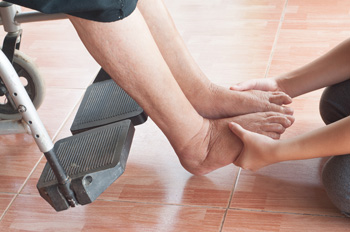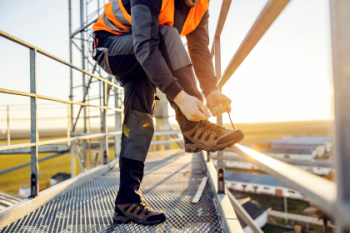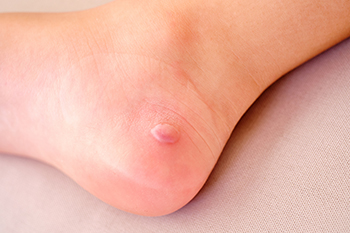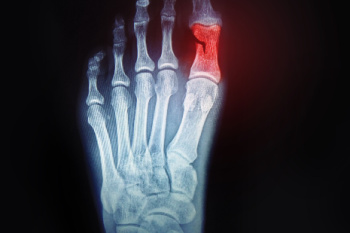Blog
Items filtered by date: September 2025
Keeping Aging Feet Healthy With the Right Care

As people age, their feet often require extra attention to stay healthy and comfortable. Natural changes such as thinning skin, reduced cushioning in the heel, and decreased circulation can make the feet more vulnerable to injury or discomfort. Common issues include dry skin, thickened toenails, corns, and calluses that may become painful, if not properly managed. Arthritis and balance problems can also increase the risk of falls and limit mobility. Choosing supportive shoes with good cushioning and non-slip soles helps protect aging feet during daily activities. Regularly checking for cuts, sores, or changes in shape is important, especially for those with diabetes. Gentle stretching or low impact exercises can keep the feet flexible and strong. If you are experiencing foot pain or difficulty caring for your feet as you get older, it is suggested that you see a podiatrist for personalized guidance.
If you need your feet checked, contact one of our podiatrists of Arch Foot & Ankle. Our doctors will attend to all of your foot and ankle needs and provide you with quality treatment.
Geriatrics and Podiatry
When people age, some common issues that may occur are bone density loss, dry skin, poor circulation, and rough brittle nails. These issues may also affect your foot health if the necessary steps are not taken to alleviate the problems.
It is important to take care of your feet because feet that are injured or diseased can affect your overall health. Having painful feet hinders your ability to do daily activities or may decrease your willingness to do the things that you need to do.
Visiting Your Geriatrician
As we age, health problems become more likely, so it is essential to visit your doctor for check-ups to ensure that you are doing the best you can to take care of your health. It is recommended to check your feet frequently for any possible cuts, bruises, swelling, corns or any other irregularities.
Taking Care of Elderly Feet
Cracked or dry feet can be treated by applying moisturizer often. It is also important not to wear old socks because the older the sock is, the higher the possibility there will be that there is bacteria there. Wear fresh socks and make sure they fit properly.
Proper foot health means that you can have a more active lifestyle and you will not be bogged down by pain. Foot health also leads to good circulation, which is paramount for overall health.
If you have any questions, please feel free to contact our offices located in Sugar Land, Houston, and Bellaire, TX . We offer the newest diagnostic and treatment technologies for all your foot care needs.
Foot Pain May Be Common Among Pregnant Women
 Many women who are pregnant notice they may have foot pain. This can be a result of water retention, pressure the growing fetus may exert on the legs, and flattening of the arch of the foot. Women may find mild relief when the feet are frequently elevated, in addition to minimizing the amount of sodium they eat, which is found in many foods and drinks. It is beneficial to incorporate a gentle exercise program into your daily routine, and this may help to increase circulation. Wearing shoes that are comfortable may help the feet feel better, and swollen feet may be minimized when fluids are frequently consumed. If you would like additional information about how pregnancy can affect the feet, it is suggested that you consult with a podiatrist.
Many women who are pregnant notice they may have foot pain. This can be a result of water retention, pressure the growing fetus may exert on the legs, and flattening of the arch of the foot. Women may find mild relief when the feet are frequently elevated, in addition to minimizing the amount of sodium they eat, which is found in many foods and drinks. It is beneficial to incorporate a gentle exercise program into your daily routine, and this may help to increase circulation. Wearing shoes that are comfortable may help the feet feel better, and swollen feet may be minimized when fluids are frequently consumed. If you would like additional information about how pregnancy can affect the feet, it is suggested that you consult with a podiatrist.
Pregnant women with swollen feet can be treated with a variety of different methods that are readily available. For more information about other cures for swollen feet during pregnancy, consult with one of our podiatrists from Arch Foot & Ankle. Our doctors will attend to all of your foot and ankle needs.
What Foot Problems Can Arise During Pregnancy?
One problem that can occur is overpronation, which occurs when the arch of the foot flattens and tends to roll inward. This can cause pain and discomfort in your heels while you’re walking or even just standing up, trying to support your baby.
Another problem is edema, or swelling in the extremities. This often affects the feet during pregnancy but tends to occur in the later stages.
How Can I Keep My Feet Healthy During Pregnancy?
- Wearing orthotics can provide extra support for the feet and help distribute weight evenly
- Minimize the amount of time spent walking barefoot
- Wear shoes with good arch support
- Wear shoes that allow for good circulation to the feet
- Elevate feet if you experience swelling
- Massage your feet
- Get regular, light exercise, such as walking, to promote blood circulation to the feet
If you have any questions, please feel free to contact our offices located in Sugar Land, Houston, and Bellaire, TX . We offer the newest diagnostic and treatment technologies for all your foot care needs.
Foot Protection for Construction Workers

Construction workers place significant stress on their feet due to long hours, heavy lifting, and uneven surfaces. Proper footwear is essential to prevent injuries and maintain foot health. Safety shoes with steel or composite toes, slip-resistant soles, and adequate arch support protect against impacts, punctures, and slips. Wearing improper footwear can lead to plantar fasciitis, stress fractures, bunions, or chronic joint pain. A podiatrist can assess foot health, recommend supportive footwear, and provide treatment for work-related injuries or pain. If you have foot pain from wearing the wrong shoes while working, it is suggested that you consult a podiatrist who can treat various foot conditions and guide you on protective footwear to wear during your workday.
While working on the feet, it is important to take the proper care of them. For more information about working on your feet, contact one of our podiatrists from Arch Foot & Ankle. Our doctors will treat your foot and ankle needs.
Working on Your Feet
Standing on your feet for long periods of time can cause stress and pain in your feet. Your whole body may experience change in terms of posture, back pain, bunions, callouses and or plantar warts. There are ways to avoid these conditions with proper foot care, smart choices and correct posture.
Positive Changes
Negative heeled shoe – Choosing this shoe type places the heel slightly lower than the ball of the foot. These are great for overall foot health. Find shoes that fit you correctly.
Go barefoot – Our feet were not designed to be enclosed for all hours of the day. Try to periodically expose your feet to air.
Eliminate Pain
Foot Exercises – Performing simple exercises, incorporating yoga and doing stretches are beneficial. This will allow increased blood flow to the area and muscles of the foot.
Achilles tendon – Stretching the foot out flat on the floor will relax the calf muscles and tendon. These exercises can be performed almost anywhere. Make sure you add these exercises to your daily regimen.
With a little bit of this information and knowing more about foot health, you will notice changes. Foot stretches and proper footwear will help with pain and prevent further issues.
If you have any questions please contact our offices located in Sugar Land, Houston, and Bellaire, TX . We offer the newest diagnostic and treatment technologies for all your foot and ankle needs.
Understanding Diabetic Blisters on the Feet

Diabetic blisters are a rare but serious skin complication that can occur in people with diabetes. These blisters often appear suddenly, usually on the feet or toes, and may resemble burn blisters. They are typically painless, filled with clear fluid, and may be surrounded by slightly red or swollen skin. Poor circulation, nerve damage, and uncontrolled blood sugar levels are common causes. While they may heal on their own, diabetic blisters are a warning sign of underlying issues and can lead to infections, if not cared for properly. A podiatrist can diagnose diabetic blisters through a physical exam and an evaluation of medical history. Treatment focuses on protecting the area, preventing infection, and management of blood sugar levels. In some cases, topical medications or dressings may be applied. If you notice unexplained blisters on your feet, especially without injury, it is suggested that you schedule an appointment with a podiatrist for proper care and monitoring.
Blisters are prone to making everyday activities extremely uncomfortable. If your feet are hurting, contact one of our podiatrists of Arch Foot & Ankle. Our doctors can provide the care you need to keep you pain-free and on your feet.
Foot Blisters
Foot blisters develop as a result of constantly wearing tight or ill-fitting footwear. This happens due to the constant rubbing from the shoe, which can often lead to pain.
What Are Foot Blisters?
A foot blister is a small fluid-filled pocket that forms on the upper-most layer of the skin. Blisters are filled with clear fluid and can lead to blood drainage or pus if the area becomes infected.
How Do Blisters Form?
Blisters on the feet are often the result of constant friction of skin and material, usually by shoe rubbing. Walking in sandals, boots, or shoes that don’t fit properly for long periods of time can result in a blister. Having consistent foot moisture and humidity can easily lead to blister formation.
Prevention & Treatment
It is important to properly care for the affected area in order to prevent infection and ease the pain. Do not lance the blister and use a Band-Aid to provide pain relief. Also, be sure to keep your feet dry and wear proper fitting shoes. If you see blood or pus in a blister, seek assistance from a podiatrist.
If you have any questions, please feel free to contact our offices located in Sugar Land, Houston, and Bellaire, TX . We offer the newest diagnostic and treatment technologies for all your foot care needs.
Important Facts About Broken Toes

A broken toe is a common injury that occurs when one of the small bones in the foot is fractured due to trauma or excessive force. Causes often include stubbing the toe, dropping a heavy object on the foot, or sports related accidents. Symptoms may involve pain, swelling, bruising, difficulty walking, or visible deformity. Risk factors include participating in high impact activities, wearing improper footwear, osteoporosis, or previous foot injuries. A podiatrist can help by diagnosing the fracture with imaging, providing proper treatment, and guiding recovery to ensure correct healing. If you think you may have broken your toe, do not ignore the pain. It is strongly suggested that you promptly contact a podiatrist who can accurately diagnose and treat this painful condition.
Broken toes may cause a lot of pain and should be treated as soon as possible. If you have any concerns about your feet, contact one of our podiatrists from Arch Foot & Ankle. Our doctors will treat your foot and ankle needs.
What Is a Broken Toe?
A broken toe occurs when one or more of the toe bones of the foot are broken after an injury. Injuries such as stubbing your toe or dropping a heavy object on it may cause a toe fracture.
Symptoms of a Broken Toe
- Swelling
- Pain (with/without wearing shoes)
- Stiffness
- Nail Injury
Although the injured toe should be monitored daily, it is especially important to have a podiatrist look at your toe if you have severe symptoms. Some of these symptoms include worsening or new pain that is not relieved with medication, sores, redness, or open wounds near the toe.
If you have any questions please feel free to contact our offices located in Sugar Land, Houston, and Bellaire, TX . We offer the newest diagnostic tools and technology to treat your foot and ankle needs.
